Robotic System
What is a Robotic System?
- ● Robotic systems are systems that perform designated tasks automatically or semi-automatically, incorporating mechanical, electronic, and software components. These systems consist of multiple disciplines, including mechanics, electrical-electronics, and software. There are many different types of robots, such as industrial robots, humanoid robots, logistics robots, service robots, and surgical robots, used in a wide range of areas, including industrial automation, healthcare, defense, agriculture, services, and entertainment.
Working Principle of Robotic Systems:
- ● Robotic systems are typically automated machines or devices capable of performing specific tasks without human intervention. The working principle of robotic systems is based on sensors collecting information from the environment, processing this data and sending it to a decision mechanism, which then triggers physical movements via actuators to perform a task. Robots continuously repeat these processes until they accomplish the task, thus enabling the robotic system to execute complex and automated operations effectively.
Apart from specialized robots, most robots generally consist of the following main components:
- 1. Mechanical Structure: The physical body that holds all components of the robot together. It is designed according to the purpose of the robot.
- 2. Sensors: These gather data from the robot’s environment to allow it to perform its task. Different types of sensors, including torque sensors, distance sensors, vibration sensors, cameras, laser profile sensors, and area scanning sensors, are used depending on the type of robot.
- 3. Actuators: Components that enable the robot to move. These usually consist of electric motors but may also include pneumatic or hydraulic drive elements.
- 4. Control System: Processes inputs sent to the robot and data received from sensors to ensure that actuators move according to the desired parameters. It consists of a computer-based system or a microprocessor.
- 5. Software: Used in running the robot’s control algorithm, motion planning, controlling peripheral equipment, and communicating with other systems. Software ensures the robot repeats the predefined movements.
In industry and manufacturing, industrial robots are commonly used. They are preferred for increasing production capacity and efficiency in repetitive tasks that require speed, high precision, and may pose risks to human life. According to ISO 8373 Standard, the classification of industrial robots is as follows:
"An automatically controlled, reprogrammable, multipurpose manipulator with three or more programmable axes, fixed in space or mobile, used for industrial applications."
Robotic Systems Used in Production and Industry:
|
Types of Industrial Robots |
||
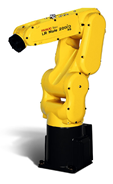 |
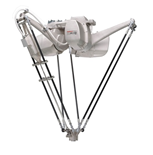 |
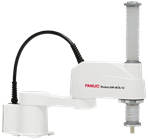 |
|
6 Axis Industrial Manipulator [1] |
4 Axis Industrial Delta Robot [2] |
4 Axis Industrial Scara Robot [3] |
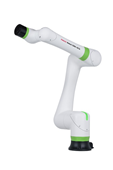 |
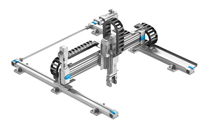 |
 |
|
6 Axis
Collaborative Robot [4] |
4 Axis Industrial Cartesian Robot [5] |
Mobile Robot [6] |
Industrial robots are generally used in automotive, electronics, and white goods manufacturing. They perform repetitive tasks such as welding, assembly, painting, transportation, packaging, and palletizing. They are used particularly in processes that require precision, tasks that need to be repeated, and applications that are risky to human life. Industrial robots vary depending on criteria such as degrees of freedom, load-carrying capacity, reach distance, speed, and precision. Robots are programmed for specific applications and equipped with tools like grippers to perform various tasks.
- 1. Articulated (Jointed) Manipulator: This type of robot has more degrees of freedom compared to other types and can carry loads between 1-2000 kg. The appropriate robot is selected based on criteria such as load-carrying capacity, reach distance, and speed.
- 2. Delta Robot: Due to its closed kinematic model, it offers advantages in terms of precision and speed compared to other robot types. They are generally preferred for "pick and place" applications.
- 3. Scara Robot: Thanks to their high-speed capabilities, they are frequently used in assembly applications. Their rigid structure in the vertical axis provides an advantage in such applications.
- 4. Collaborative Robot (Cobot): Industrial robots should not work in the same environment as humans due to safety concerns. Robots are separated from their environments using fences. Collaborative robots, or cobots, are systems designed to work directly with human operators, providing safe, flexible, and easy-to-use systems. Cobots are equipped with advanced safety features to work directly with humans, such as collision detection and limitations on speed and force. Unlike traditional industrial robots, cobots can share the same workspace with humans and interact with them safely.
- 5. Cartesian Robot: Cartesian robots are a type of robot where each axis moves linearly (x, y, z), and the axes typically intersect at right angles. The main advantage of Cartesian robots is their ability to provide precise and repeatable movements thanks to their simple kinematic model and robust structure.
- 6. Mobile Robot: These robots are used for automatic load transportation in autonomous transportation, storage, and logistics processes. AGVs (Automated Guided Vehicles) and AMRs (Autonomous Mobile Robots) fall into this category. Mobile robots can work both indoors and outdoors and have different operating types, such as lane navigation, laser navigation, and natural navigation.
Applications of Industrial Robots:
- 1. Automotive: Various robot types are commonly used in processes such as assembly, welding, painting, quality control, and material handling.
- 2. Electronics: Robots are extensively used in precision assembly, PCB manufacturing, and testing processes.
- 3. Food and Beverage: The use of robots in packaging, palletizing, cutting, and processing increases production volumes.
- 4. Logistics and Storage: Mobile robots are used to speed up and automate processes such as warehouse management, material handling, and inventory control.
- 5. Healthcare: The use of surgical robots and robots for rehabilitation is increasing in the healthcare sector. Robots are also used in laboratory automation and pharmaceutical production to ensure error-free processes.
- 6. Agriculture: Special-purpose robots are developed to increase efficiency and speed up processes in agriculture. In addition, the use of drones for agricultural spraying is becoming widespread. Drones offer time and cost advantages compared to traditional methods involving human labor or large machines like tractors.
The Use of Robotic Systems in Production and Industry:
Robotic systems are used in a wide range of industries to increase efficiency, reduce costs, and improve quality. These systems, at the core of automation processes, perform repetitive and time-consuming tasks quickly and accurately. Robots can operate in environments where human labor is insufficient or dangerous, thereby reducing workplace accidents and improving safety. Moreover, robotic systems provide uninterrupted operation on production lines, minimizing human error and increasing production capacity. With the digitalization of production processes, robots enable the creation of flexible production lines, allowing for customized production and rapid product changes. Additionally, the integration of artificial intelligence and machine learning allows robotic systems to gain autonomous decision-making abilities, offering smarter, more customized, and adaptive production processes. These advancements are revolutionizing the manufacturing sector under concepts like Industry 4.0 and smart factories, enhancing businesses’ competitive advantages.
- ● Assembly and Production Line Automation:
- ● Robots perform repetitive assembly tasks quickly and with high repeatability.
- ● By operating continuously on production lines, they increase production speed and efficiency.
- ● Welding Process:
- ● Industrial robots perform precise welding tasks that humans cannot achieve with the same quality.
- ● Robots ensure safe execution by minimizing the effects of harmful gases used in welding processes that pose risks to human health.
- ● Painting and Coating Process:
- ● Robots provide the same uniformity and quality in every product in challenging processes like painting and coating.
- ● By using robots, the risk of exposure to harmful chemicals for human health is eliminated.
- ● Packaging and Packing:
- ● Robotic systems enable fast and accurate packaging of products that humans cannot handle due to weight.
- ● They can automatically and flexibly pack products of different sizes.
- ● Quality Control:
- ● Robots integrated with image processing and sensor technology automatically perform quality control of products.
- ● They minimize human errors in quality control, enhancing product quality and brand prestige.
- ● Material Handling and Storage:
- ● Robots enable the transportation of heavy or bulky materials and optimize warehouse management through automation.
- ● With automated guided vehicles (AGVs) and autonomous mobile robots (AMRs), logistics processes are accelerated and automated with fewer errors than human labor.
- ● Hazardous and Difficult Working Conditions:
- ● Robotic systems can operate safely in environments that are dangerous or challenging for human health.
- ● They perform tasks flawlessly in challenging conditions such as toxic, radioactive, or extreme temperatures.
- ● Flexible Production and Customization:
- ● Robots can quickly adapt to product changes and different production environments.
- ● They enable rapid adaptation to changing production demands. They increase profit margins in small-scale, customized production.
Advantages of Using Industrial Robots:
- 1. Increased Efficiency: Robotic systems perform repetitive tasks in production processes with high speed and precision, increasing production speed. They prevent unplanned production stops caused by human-related events such as pandemics.
- 2. Quality Control: Robots reduce human errors, improving product quality and ensuring that high standards are maintained.
- 3. Cost Reduction: Robots reduce labor costs while increasing efficiency in production processes. They optimize energy and material consumption. By reducing human labor and error rates, production costs decrease.
- 4. Flexibility: Robots can quickly adapt to different production processes, allowing for rapid adaptation to changing market demands.
Workplace Safety and Employee Health: Robots handle dangerous and challenging tasks for human life, ensuring workplace safety and preventing accidents. They allow employees to work in less stressful and safer jobs.
The Future of Robotic Systems:
Robotic systems have continued to revolutionize the industry since the industrial revolution. Technological advancements are enhancing the functionality and capabilities of robots, creating smart and autonomous systems that will collaborate with humans in the future world of production. In this context, concepts such as human-robot collaboration, smart factories, and Industry 4.0 play a critical role in transforming production processes.
Human-Robot Collaboration:
Industrial robots pose risks in terms of working with humans due to their high speed and high carrying capacity. However, modern robotic systems are designed to interact with humans safely and efficiently. Thanks to these new-generation robots and sensors, robots work integrated with human labor in production processes. Human-robot collaboration offers several advantages:
- 1. Safety: Advanced sensors and collision detection technologies allow robots to work safely with humans.
- 2. Efficiency: Humans and robots can share complex tasks, speeding up production processes and reducing error rates, thus making human tasks easier.
- 3. Flexibility: Cobots can be quickly reprogrammed for different tasks, enabling fast solutions for changing needs in production lines.
- 4. Workforce Optimization: By using robots for repetitive and challenging tasks, humans can focus on more creative and strategic tasks.
- Smart Factories:
Smart factories are production facilities that integrate digital technologies into their processes and have machines with data-driven decision-making capabilities. These factories optimize and automate production processes using technologies such as sensors, IoT devices, big data, robotics, image processing, and artificial intelligence. The development of robotic systems is causing revolutionary changes in factories, with the concept of "dark factories" being at the forefront. In traditional production facilities, basic needs such as lighting, heating, and cooling depend on human labor. However, robotic systems do not require such needs, significantly reducing energy costs and minimizing environmental impacts. Smart factories offer significant changes and advantages in production processes with the integration of advanced technologies:
- 1. Communication Systems: In smart factories, all machines and automation lines communicate with each other, allowing them to work synchronously without human intervention. These systems ensure efficient and harmonious cooperation between machines and optimize production processes.
- 2. Autonomous Production: Artificial intelligence and machine learning algorithms monitor and optimize production processes in real-time, ensuring maximum efficiency with minimal human intervention. Tools such as cameras and sensors give robots and machines the ability to understand their environment. The integration of advanced technologies such as artificial intelligence and computer vision increases the flexibility and capabilities of robotic systems. Robots can make smarter decisions by sensing environmental conditions and adapting immediately to changing situations.
- 3. Predictive Maintenance: Sensors and data analysis predict the maintenance needs of machines in advance, minimizing breakdown issues and ensuring continuous production. Predictive maintenance prevents unexpected breakdowns and costly downtimes, increasing overall operational efficiency.
Industry 4.0:
Industry 4.0 is a concept that advances digitalization and robotic automation in the manufacturing sector. This concept represents a revolution in the industry, where robotic systems are at the heart of the deep integration of physical production systems with digital technologies. Industry 4.0 aims to make production processes smarter, more efficient, and more flexible, increasing the competitive advantage of businesses and offering a more dynamic structure in global markets.
- 1. Internet of Things (IoT): IoT devices provide data exchange between machines and systems on production lines, offering real-time monitoring and control. These devices transmit data collected by sensors to central systems, providing critical information to optimize processes and increase operational efficiency. IoT increases transparency in production processes, helping to determine maintenance needs in advance and maximize energy efficiency.
- 2. Big Data and Analytics: Large volumes of data generated from production processes are processed using advanced analytical methods. Big data analytics enable the identification of trends, anomalies, and opportunities in complex production processes. These analyses support decision-making processes, increasing the performance of production lines and providing businesses with strategic advantages. Big data also drives innovation in product development processes and allows faster responses to customer demands.
- 3. Cloud Computing: Cloud computing technologies enable the secure storage, processing, and analysis of data collected from production processes on a central platform. This allows global access to production data, enabling businesses to rapidly adapt their production processes. Cloud computing also facilitates collaboration and data sharing, creating a more coordinated and flexible structure in the supply chain.
- 4. Artificial Intelligence and Machine Learning: Artificial intelligence (AI) and machine learning (ML) technologies automate decision-making mechanisms in production processes, ensuring continuous optimization of these processes. AI systems analyze, learn from, and predict potential issues in production lines using information from sensors and other data sources. Machine learning algorithms make production processes more efficient over time and enable robots to operate autonomously. Thus, robots and machines can manage themselves by quickly adapting to environmental conditions.
The Future of Robotic Systems: New Technologies and Trends
- ● The future of robotic systems is being shaped by the widespread adoption of human-robot collaboration, smart factories, and Industry 4.0. This transformation is increasing efficiency, flexibility, and sustainability in production processes. For example, a robot on a production line can immediately stop the production process and send a warning notification to authorized personnel when it detects an error during quality control. Such capabilities minimize errors in production, improve product quality, reduce costs, and enhance brand prestige.
- ● The future of production is shaping up around smart factories and autonomous production lines. Investments are being made for future factories to be managed entirely by autonomous systems with much less need for human intervention. The harmony between human labor and technology increases innovation and competitiveness, allowing the global manufacturing sector to undergo a more dynamic and high-quality transformation. For this reason, technologies related to artificial intelligence and robotic systems will play a more dominant role in future production processes.
References:
- 1. Fanuc America. (n.d.). LR Mate 200iD/4S. Fanuc America. Accessed at: https://www.fanucamerica.com/products/robots/series/lr-mate/lr-mate-200id-4s
- 2. Fanuc America. (n.d.). DR 3iB Series Delta Robots - DR 3iB 8L. Fanuc America. Accessed at: https://www.fanucamerica.com/products/robots/series/dr-3ib-series-delta-robots/dr-3ib-8l
- 3. Fanuc America. (n.d.). SR-6iA C - Food Grade. Fanuc America. Accessed at: https://www.fanucamerica.com/products/robots/series/scara/sr-6ia-c-food-grade
- 4. (n.d.). CRX-10iA. Fanuc. Accessed at: https://www.fanuc.eu/tr/tr/robotlar/robot-filtre-sayfas%C4%B1/ortak-%C3%A7al%C4%B1%C5%9Fma-robotlar%C4%B1/crx-10ia
- 5. Festo Blog. (n.d.). Why Use Cartesian Handling Systems? Accessed at: https://festoblog.com/why-use-cartesian-handling-systems/
- 6. (n.d.). MD Series. Omron. Accessed at: https://industrial.omron.com.tr/tr/products/md-series



